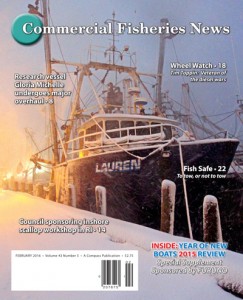This is the time of year, perhaps more than any other, when fishermen get into distressful situations.
Throughout our region, the water is cold, the weather is variable, the air temperature freezes spray onto the windows, rails, decks, and superstructures, and the sea turns its grayest faces and fiercest crests toward us.
 The captain seeks refuge in the lee of the storm or tries to beat the storm to port.
The captain seeks refuge in the lee of the storm or tries to beat the storm to port.
But then something unexpected happens – steering fails, or the engine stops, or the trawl hangs up on bottom rocks.
A distress call is made to a nearby captain or to a friend who then quickly has to decide whether or not he has the equipment, knowledge, and skill to become a good Samaritan.
Hard choice – because fishermen are always ready to help each other. We see this constantly both on the ocean and shoreside in the region’s many fishing communities.
Suppose that you are the captain who has just been asked, or has volunteered, to provide a tow to a vessel in distress.
The very first step is to assess the risk.
The important questions include:
• Can this maneuver be done safely without risk to human life or loss of either vessel?
• What is the weather situation and trend?
• Do you have the right towing materials, suitable engine, and experience /expertise?
• Would it be safer and save precious time in the long run to get the US Coast Guard or other professionals involved at the outset?
Safe working load – towline
What do you have available for towline?
All line materials have their own breaking strength and safe working load.
Synthetics have a higher breaking strength and more stretch than manila or hemp lines.
SafeBoat.com recommends polypropylene 1) because it floats and is more likely to stay out of the towing boat’s propeller, and 2) because it is less elastic than nylon and doesn’t have as much whiplash or recoil energy should it part.
The downside of polypropylene is that its strength comparison factor (CF, compared to manila line) is 1.4, whereas the CF for nylon is 2.5.
Polyester line, also a possibility, does not float and has a slightly higher (better) comparison factor (2.0) compared to polypropylene.
You can calculate the safe working load (SWL) of your towline.
First determine the breaking strength (BS) using this formula:
BS = circumference squared (C2) times 900 pounds, then for non-manila line multiply the BS times CF (1.4 for polypropylene or 2.0 for polyester). Finally calculate the SWL as BS/SF (safety factor for natural or synthetic line- available in many texts.)
Example: Find the BS of 1” diameter polypropylene line (1” diameter = 3.1416” circumference) and then the Safe Working Load (SWL). BS = C2 x 900 or BS = (3.1416)2 x 900 lbs = 8,882lbs. Then BS x CF (polypropylene) or 8,882 x 1.4 = 12,435.8 lbs. The breaking strength of 1” Poly is 12,435.8 lbs. SWL = BS/SF or SWL = 12,435.8/5 (SF = 5 for poly in good condition) = 2,487.2 lbs.
Two points to be made here:
• The breaking strength in pounds is very different from/higher than the safe working load of a line. One should never tow close to the breaking strength of a line; and
• The larger the diameter of the towline, and the better the condition of the line, the higher the safe working load.
One cool way to tell if you are approaching the safe working load of a towline is to use the manufacturer’s specifications for “elongation at break ” as follows:
• Divide the “elongation at break” percentage by 2 (1/2 the stretch is assumed to be the safe working load). Example : 36%/ 2 = 18%.
• Multiply 6 feet (random number for example purpose) by 1.18%.
Example: 6 x 1.18 = 7.08 feet.
• Place two markers on the towline 6 feet apart. Tie a second very lightweight line such that it is 7 feet in length between the markers.
• If the lightweight line becomes taut during towing, the safe working load of the towline has been reached.
• Divide the “elongation at break” percentage by 2 (1/2 the stretch is assumed to be the safe working load). Example : 36%/ 2 = 18%.
The integrity and location of the fittings on both vessels are also a major concern.
Cleats, hooks, and shackles all have their respective safe working load values.
The towline should be attached to the towed boat as close to its centerline as possible and as close to the waterline as feasible.
Only fittings attached with backing plates and bolts not screws should be considered useable.
All of the above should be evaluated as part of the risk assessment.
Safe towline length
If the towline is believed to have an adequate safe working load but is short, then the tow should not be undertaken.
Here the consideration is the wave height and periodicity.
The best towing practice is to have a towline length that will allow the two vessels to be “in step” (i.e. both are either climbing a wave or coming off the crest) and the vessels should be two to three waves apart.
When vessels are not in step, there is a high risk of burying the bow of the towed vessel which creates very large shock forces on the towed vessel and towline.
The stern of the towing vessel could become swamped at this time because the towed vessel is pulling back on and slowing down the towing vessel.
The towline should be lengthened until the vessels are in step.
Also there should be a catenary or dip in the towline when the tow is done properly. The catenary absorbs some of the shock of waves and wind and hull resistance during the tow.
To create a catenary, lengthen the tow rope, or if using float rope, add a buoy, chain, or second piece of line to the towline.
The potential for the need to adjust the length of the towline means that the line must be constantly monitored and affixed to the towing vessel so that it can be adjusted quickly and safely.
Safe towing speed
Just as there are principles associated with safe working load, there are principles associated with safe towing speed.
With a displacement hull, as is common in most commercial fishing boats, the critical speed or hull design speed is 1.34 times the square root of the length at the waterline.
Thus a boat with a waterline length of 50’ has a critical speed of 1.34 x √50 or 1.34 x 7.1 = 9.5 knots.
However the maximum safe towing speed is only 90% of the critical speed; in this example the safe towing speed is 9.5 times 0.90, or roughly 8.5 knots.
Sea, wind, and currents may necessitate a major reduction in safe towing speed.
The practical safe towing speed could be half or less than half of the calculated safe towing speed. Moreover, weather conditions are subject to change, so towing speed must change accordingly.
This discussion is only a small fragment of what needs to be said about safe towing.
As I am not an expert in this towing area, I suggest further reading and consultation with professionals.
I turned to my colleague Fred Mattera (SAFE BOAT-SMART BOAT) for input on this article and here are some of his comments: “This is difficult because there are so many variables and hypotheticals.
“Trawlers as the towing vessel will use their winch wire (varying from 5/8” to 1-1/4” based on vessel size) and the scope (length of wire used) will vary based on weather and sea conditions (100F to 200F wire) relying on the towed vessel to use heavy rope (preferably braided line/strength and flex) to act as the shock absorber. A vehicle tire can also provide this outcome.
“Ratio’s and formulas will be forgotten and rarely used. Fishermen will usuallly resort to overkill, meaning both main winch wires together, new heavy duty shackles, and the largest in diameter rope/line rigged as a bridle for the towed vessel, with as much scope of wire possible, and a slow speed of 2.5 to 4 knots based on weather conditions.
“The key is to be certain you have the right material to attempt to tow a vessel and to know that refusing is a safe option at times.”
Remember: It is honorable and responsible to decline being a good Samaritan if your materials and skills are not up to providing safe assistance.
Ann Backus, MS, is the director of outreach for the Harvard School of Public Health’s Department of Environmental Health in Boston, MA. She may be reached by phone at (617) 432-3327 or by e-mail at <abackus@hsph.harvard.edu>.
 Get more CFN in the February Issue –
Get more CFN in the February Issue –
please choose from the following options:
BUY a Single PRINT edition of CFN that is delivered by MAIL.
Click Here for PRINT EDITION
Quickly enjoy ONLINE access with our feature packed flip-book.
PURCHASE ONLINE EDITION
(Read online flip-book immediately with access key and download a copy for yourself. Not sure? SAMPLE HERE)
SAVE BIG when you SUBSCRIBE!






